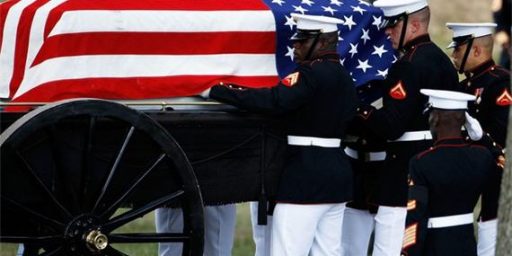THE COFFINS
Martha Brant and Trent Gegax want to see them:
DEATH ANNOUNCEMENTS ARE arriving almost daily for American soldiers killed in Iraq. It’s hard to put a weekly average on the number of dead because some weeks there are no casualties. [I’m guessing you weren’t a math major? -ed.] But by my unofficial tally, somewhere between three and six soldiers die every week in Iraq.
And yet, it often feels like the American public has no sense of the steady trickle of killed and wounded. I’ve had some people tell me that it’s our fault; the media are not covering the deaths the way we did during the war. Others say it’s because the numbers are so small compared to, say, Vietnam, the news doesn’t catch people’s attention.
I’ll offer a different reason: there are no pictures. As much as I hate to admit this as a print reporter, images do sear into people’s mind more than words. Nick Ut’s photograph of 9-year-old Kim Phuc became synonymous with the Vietnam War. She was the terrified little girl running naked, covered in napalm. Television images of caskets and body bags also changed public opinion about the war.
But there are no images of flag-draped coffins in this war to remind people of the human price being paid. That’s because the media are prohibited from filming or photographing soldiers’ remains being sent home. Most fallen soldiers’ bodies get sent back to Dover Air Force Base in Delaware, where they are identified and prepared for burial. During the Vietnam War, photographers and film crews were often at Dover taking pictures of the “dignified transfer of remains.” But for more than a decade, the Department of Defense has cut off that access.
In Vietnam, we had roughly 58,000 killed, most of them in the 1968-1972 span. Let’s say 50,000 during those 5 years. That’s 192 a week. In World War II, there were several days with death tolls over 1,000. And we buried the bodies overseas. The ability to individualize the deaths in Iraq is a sign of how well things are going, not of failure.




Problem here is that the American involvement in Vietnam started at the tail end of the Eisenhower administration. By the time a full scale war broke out we had been there as “advisors” to the army of South Vietnam (but really to support the government we favored) at a time when North – South hostilities were well under way. The difference is in Iraq the “war” was fought up front but what we are doing there now has a lot in common with our involvement in Vietnam in the years 1959 to 1967. Now what happens if full scale civil war brakes out due to the undeniable undercurrent of ethnic tribalism? (not to mention all of the ancillary problems that could come up as a result.)
Those flames are already being fanned and it has nothing to do with hatred of the US or terrorism. Not unlike the former Soviet satellites where ethnic factions took up violence as soon as the yoke of soviet oppression was removed the same thing could very well ignite in Iraq, especially since there are more then enough outside influences that would support precisely such chaos. Then the US would have to make a decision, stay, choose up sides and fight, or leave.
Frankly now that we are in I say we need to finish the job, but the facts are that this could still turn very ugly and all of the happy talk about building schools and hospitals is only serves to give people the impression that we are simply in mop up mode and that the specter of a real quagmire (not the media version of one) is out of the question.
There are over 300 murders a year in almost every major metropolitan area: New York, Los Angeles, Detroit, etc., so about 5-6 a week.
(CNN states over 18,000 murders a year in the U.S. as of 1997 so a combined total of nearly four dozen people a day in the U.S. and don’t start sniping about guns since a good many of these are by knives, strangulation and other good ol’ fashioned ways to kill your fellow man).
How come we don’t see these bodies of people dying in OUR cities every week?
Actually, you do–if you watch the local news in those cities. But otherwise not.
Rick,
Your timetable is right but I don’t think the comparison works. During that entire period, there was a civil war going on and it was just a matter of what our involvement was going to be. In Iraq, we initiated the war and rather quickly eliminated the government. Now, our forces are fighting what appear to be very small bands of very loosely organized guerillas–nothing equivalent to the VC, NVA, or Red Chinese.
James, granted but the question is, of which I don’t know the answer, are the various Iraqi factions just biding their time until or are they committed to working toward what is largely a US goal of a free democratic state? What if the factions have other plans that don’t include one man one vote?
“The ability to individualize the deaths in Iraq is a sign of how well things are going, not of failure.”
A classic apologist interpretation of events and circumstances. Since Bush declared the mission accomplished months ago, the daily GI obituaries cannot be considered a sign of success.
—